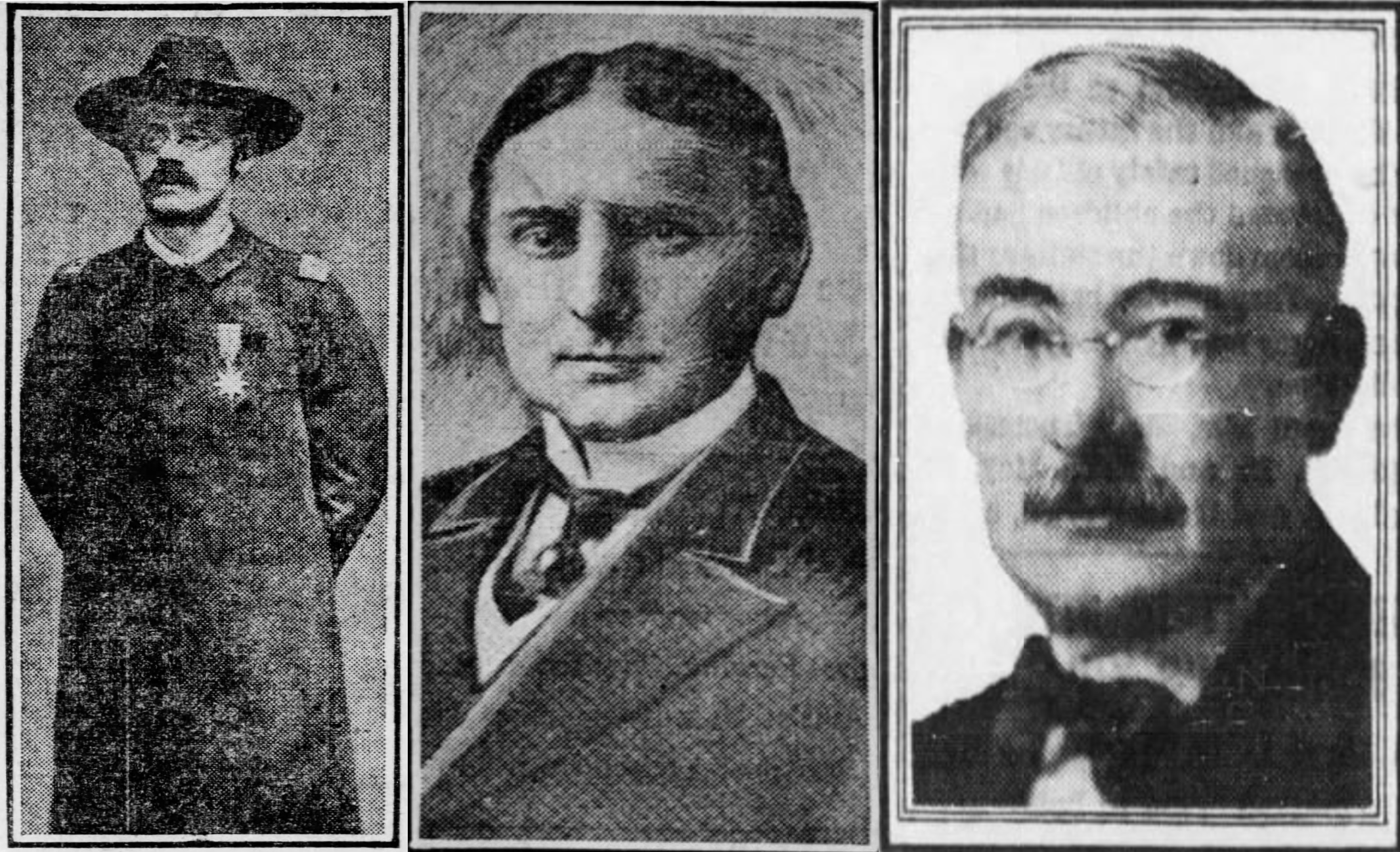
Above, Producer Earl Carroll Signs up a local dancer to be in the touring production of his show Earl Carroll Vanities, 1925. Below, the dancer - and Carroll's current girlfriend - Kathryn Ray on the cover of racy publication The National Police Gazette after nude lobby photos of her had gotten the producer arrested in New York City.
Above, Ted Lewis and a newspaper ad for his Frolic. A YouTube video of Ted Lewis and his band- one that we used for a lot of sound cues for the episode, can be found here:
https://www.youtube.com/watch?v=WADhw1temyM
Below, General Smedley Butler (left) and Philadelphia Mayor W. Freeland Kendrick (right):
Next, three Philadelphia theater censors that we discuss in this episode -
Left: Revered Frederick Poole, in a photo published in the Philly newspapers in 1909 as he made another trip to China. I wish I could have found a photo of Poole from the 1920s, but as yet I haven't come across one.
Center: Henry Starr Richardson in a photo that is also from the early 20th Century. A sometime playwright and journalist, Richardson had become a minor political functionary and starting in 1918 was appointed the head of the Philadelphia Board of Movie Censors. The board had been created in response to Sarah Bernhardt's supposedly 'shocking' performance in the film Joan of Arc. Richardson continued to be a censor of movies and plays in Philadelphia into the 1950s.
Right: Thomas M. Love, a "theatrical man" and employee of the Zimmerman-Nixon theater syndicate, in a photo from the 1930s. A former general manager of the Broad, Garrick and Erlanger Theatres in Philadelphia, he became the chair of the Board of Theatrical Censors in 1926, and remained in office for eight years. He was also a treasurer of the Edwin Forrest Home for Actors.
We were very pleased to be able to work the Marx Brothers' show I'll Say She Is into this episode. It had a script cobbled together with skits from their former vaudeville act - especially the opening scene in a theatrical agency, where the four brothers come in one by one to ‘try out’. There was also a Napoleon skit, which the four men always considered some of the best work they ever did. The ensemble included the leading lady Muriel Hudson, a couple of ‘sister act’ duos, and a large assortment of chorus girls. They brought it to the Walnut Street Theatre in the summer of 1923.
“It breaks all the speed limits of a conventional summer review,” wrote the North American. “The chorus numbers, comedy scenes and specialties succeed each other with such bewildering rapidity that constant hustling is required to keep up with the performance.” The reviewer for the Philadelphia Record returned to see it again and again and proclaimed it was getting better every time. “It’s the perfect summer show,” crowed the Public Ledger. “Pretty girls, dancing ensembles that touch the top-most type of theatrical beauty, and the Four Marx Brothers, who submit an unusual quality of fun, follow on the long program in a delightful manner that spells cool and invigorating pleasure.” Only the Inquirer remained lukewarm to the zany quartet’s charms. “Interesting and entertaining” was all that its critic would say. It might last the summer, it allowed, praising each of the men not by their character names (Groucho, Harpo, Chico, and Zeppo) but by their actual names: Julius, Arthur, Leonard, and Herbert.
I’ll Say She Is did indeed last the whole summer - pausing only for one night, August 9th, to mark the passing of President Warren G. Harding. It played for a full thirteen weeks, and then went on a national tour. It returned to the Walnut again in May 1924 before finally opening in New York. There the show wowed influential critics like Robert Benchley and Alexander Woollcott, and catapulted the Marx Brothers to major star status.
The Marx Brothers never filmed the show as they did with some of their later stage successes. But when they were publicizing the movie Monkey Business, they did record a short film with a sketch from I'll Say She Is, as they had once performed it at the Walnut:
https://www.youtube.com/watch?v=lxABVaGgWyo
Finally, Sally Rand, in a photo she happily provided to the Philadelphia Inquirer in October of 1933 - and which it just as happily printed.
The Inquirer, we should add, had long provided its readers with many images of scantily dressed women from the burlesque theaters of Philadelphia, on a regular basis. Similar images can be found in the newspaper archives dating back to the 1890s.
Sally Rand can be seen doing a version of her fan dance in this colorized YouTube video:
https://www.youtube.com/watch?v=HQ6Kl6hgSCo
Selected Bibliography:
Books
Dudden, Arthur P., “The City Embraces ‘Normalcy,’ 1919-1929,” in Philadelphia: A 300-Year History, Russel F. Weigley, ed., W.W. Norton & Company, 1982, pp. 566-600.
Keels, Thomas H., SESQUI! Greed, Graft, and the Forgotten World’s Fair of 1926, Temple University Press, 2017.
Laufe, Abe, The Wicked Stage: A History of Theater Censorship and Harassment in the United States, Frederick Ungar Publishing Co., 1978.
Murray, Ken, The Body Merchant: the Story of Earl Carroll, Ward Ritchie Press, California, 1976.
Schmidt, Hans, Maverick Marine: General Smedley D. Butler and the Contradictions of American Military History, The University Press of Kentucky, 1998.
Newspaper Articles (in chronological order):
"Censoring Sacred Codfish," Evening Public Ledger, January 7, 1915, p. 11.
"Court Order Opens Door of Playhouse Closed by Mayor," Philadelphia Inquirer, September 7, 1923, p. 1.
"Stage Uplift Aimed," Philadelphia Inquirer, January 13, 1924, p. 11.
"Theatre Managers Welcome Censors," Philadelphia Inquirer, February 28, 1924.
"Carroll Show 'Put On' Even If Tights Are Not," Philadelphia Inquirer, February 17, 1925, p.2.
"Vanities Clothes Adorn - Lockers," New York Daily News, February 18, 1925, p. 25.
"'Vanities' Still Displeases Censors," Philadelphia Inquirer, February 18, 1925, p. 2.
"Stage Clergy Defended," Philadelphia Inquirer, April 3, 1925, p. 16.
"Pastor To Act In Play," Philadelphia Inquirer, June 4, 1925, p. 2.
"Censors Philadelphia As Being Provincial," Altoona Mirror, January 20, 1930, p. 7.
"Clergy Criticized By Theatre Censor," Philadelphia Inquirer, May 31, 1931, p. 17.
"City Theatre Censorship," Philadelphia Inquirer, February 11, 1932, p. 8.
"Engages Sally Rand," Philadelphia Inquirer, October 11, 1933, p. 11.
"Fan Dancer Told to Add a Stitch or Two to Skin Balms That Pass For Her Costume," Philadelphia Inquirer, October 12, 1933, p. 3.














